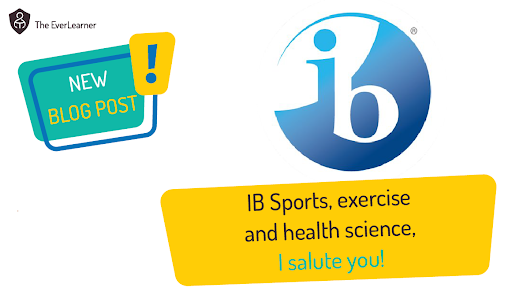10 things all PE and Sport teachers should know about IB Sports, Exercise and Health Science 2024
Dear PE colleagues,
The new International Baccalaureate Sports, Exercise and Health Science (IB SEHS) course is fascinating. So much so that, despite its more international than UK-centric usage, I believe that all PE and Sport teachers need an awareness of it.
Before I get into the top 10, a little bit of context. Prior to September 2024, IB SEHS has been a feature of the IB Diploma programme and has been a respected and popular qualification in the independent sector in the UK, as well as in international schools around the world. It has also been popular in the US system, with many state-funded schools offering the IB programme as an alternative to the AP structure.
So, why does all this make it important for UK-based, typically state and academy PE and Sport teachers to be aware of it? Here’s why:
The new IB SEHS 2024…
- …is a core science subject.
- …sits alongside biology, chemistry and physics within the IB diploma programme.
- …includes three scientific themes only.
- …includes one (of two total) multiple-choice-only sections in exam paper 1.
- …includes investigative writing coursework with the theme chosen by the candidate.
- …has a supporting textbook which is written far above the level of the specification.
- …has intertwined topic areas.
- …has explicit linking questions built into the specification.
- …contains sports science content never taught in any other school-based PE or Sport course.
- …provides a potential blueprint for future A-level PE courses.
1The new IB SEHS 2024 is a core science subject
How many times have you thought that PE and sports science/studies, when taught and learned well, are just as important to a balanced learning programme as core science? I have contemplated this on many occasions and IB obviously have too because IB SEHS 2024 is one of four science subjects (only) and is considered a core science.
For this reason, IB SEHS is a rigorous and scientifically focused qualification that will challenge PE and Sport teachers to up their scientific game. Having already taught and recorded my teaching of the entire course, I can confirm that the subject content and skills are authentically scientific and can stand tall as a true science course.
2The new IB SEHS 2024 sits alongside biology, chemistry and physics within the IB diploma programme
Leading on from the first point, IB students must select one of four sciences for their diploma programme. The four options are:
- Biology
- Chemistry
- Physics
- Sports, Exercise and Health Science
This allows centres to offer a broader experience and choice within science and allows students to “switch up” their science experience into a more applied and, perhaps, personal experience of science. Whilst biology, chemistry and physics can certainly be personal, SEHS allows students to understand themselves, their choices, their motivations and, perhaps, the nature of lifelong movement. I believe this is extremely positive.
3The new IB SEHS 2024 includes three scientific themes only
Whilst all A-level PE courses include social studies including contemporary issues and historical references, the IB SEHS 2024 does not. Rather, the course is taught and learned with reference to three intertwined themes:
- Exercise physiology
- Biomechanics
- Sport psychology
That’s it! But the theme titles belie the modern and intriguing content that is contained within each theme. One of the strong features of the IB SEHS is that the content is not based on an assumed model of previous courses; it is built from the ground up as a fresh model of content and I will describe some of this later in this article.
4The new IB SEHS 2024 includes one (of two total) multiple-choice-only sections in exam paper 1
IB requires students to complete two exams. Paper one contains two sections. Section 1a and section 1b. Section 1a is entirely based on multiple-choice questions. Whilst this might surprise a few teachers, it should be considered that this type of assessment as a part of the overall rubric allows for a modern form of assessment which may be, in the future, computer-based and automated.
Section 1b involves data-based questioning and short answer questions too. Once again, this will allow for efficient marking and analysis by IB.
5The new IB SEHS 2024 includes investigative writing coursework with the theme chosen by the candidate.
All IB SEHS learners will design their very own, unique piece of coursework. The scientific investigation allows students to establish their own research question and then investigate it fully and deeply.
If we look at almost all other non-examined assessments in PE courses such as A-level and GCSE, there is little to no individuality contained within them. The IB SEHS allows students the opportunity to go further and deeper in areas that fascinate them and I applaud IB for this stance.
6The new IB SEHS 2024 has a supporting textbook which is written far above the level of the specification.
The IB SEHS textbook is brilliant. I mean, brilliant! At a time when textbook writers are almost judged for only mentioning things that are explicitly referenced in a specification document, the IB authors have chosen to provide a more rounded, researched approach to textbook writing. If we consider that this will facilitate students’ initial readings in the scientific investigation section of the course, this decision makes sense. Students will be expected to take one section of the course much further so, the authors have made a point of doing this throughout.
Those of you who, like me, are old enough to remember when textbooks were more rounded than the current trend will celebrate this.
7The new IB SEHS 2024 has intertwined topic areas.
This is where I am particularly impressed by the authors of the new IB SEHS. Every aspect of the course is potentially linkable to every other and the links between them feel organic and real. This will encourage teachers to teach for understanding and application because the course is logically structured and mastery of concepts will facilitate future learning.
8The new IB SEHS 2024 has explicit linking questions built into the specification.
The specification document clearly identifies probable or potential linking questions within each section. These linking questions challenge the teacher to consider the position and association of each learning element in relation to every other. At first glance, this feels really challenging but, once you become familiar, the linking of questions encourage you, as the teacher, to consider the associated and comparative concepts in the course.
9The new IB SEHS 2024 contains sports science content never taught in any other school-based PE or Sport course.
The IB SEHS content is fantastic! Whilst it will be challenging for the first cycle of teaching, the authors have deliberately ensured that the course is up to date and intriguing for the learner. Whilst what follows is simply my opinions, I wanted to list three lessons from each theme that I have really enjoyed teaching:
Theme A: Exercise physiology and nutrition of the human body
- Reproductive hormones and health
- The gut microbiome and health
- Low energy availability (LEA)
Theme B: Biomechanics
- Levers outside the body
- Coefficient of restitution
- Anthropometry and anthropometric databases
Theme C: Sports psychology and motor learning
- Mastery and ego climates
- Mental toughness
- Paivio’s imagery framework
Whilst all teachers and learners will have their own favourites, I really enjoyed learning about and teaching these topics and I’m confident you will too.
10The new IB SEHS 2024 provides a potential blueprint for future A-level PE courses.
In the coming years, UK-based courses like A-level PE will be under review and, I believe, the IB SEHS course demonstrates what is possible. I urge exam board colleagues to look closely at the IB course and to seriously consider how some of the features I have described above could be incorporated.
Thanks for reading.
James
%20Text%20(Violet).png)



